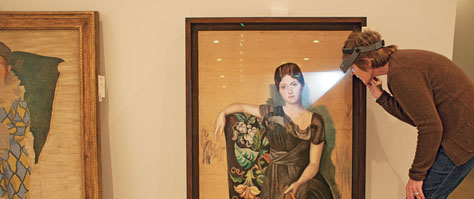
Photograph by Andrew Tolson
“With Les Demoiselles, Picasso sent a kind of manifesto out into the world. He wanted to tell people, this is why art will now be different.”
— Anne Baldassari
New Exhibit at the AGO Gets Inside Picasso’s Head
A work was never complete for the artist, who was his own best collector.
—
Pablo Picasso is sketching in the park when a bold woman approaches. “It’s you,” she says, “The world’s most famous artist. You must draw my portrait! I insist.”
Picasso studies the woman’s face and renders her image with an extended line. “It’s perfect!” she gushes. “What do I owe you?”
“Five thousand dollars,” Picasso replies. The woman gasps. “How could you want so much money?” she says. “You drew the picture in seconds!” His response: “Madame, it took me my entire life.”
While no one knows whether this legendary anecdote is true, its punchline is the take-home message of Picasso: Masterpieces from the Musée National Picasso, a touring exhibition that comes to the Art Gallery of Ontario May 1 after a stop in Sydney, Australia. Featuring 147 works, it’s the most comprehensive travelling exhibition of Picasso works ever displayed, and one that documents how every piece was a step to another work. We see how Picasso went from painting a fragment of a newspaper banner to ripping them out and gluing them on his canvases, thereby inventing collage. It will feature a bronze sculpture of mistress Marie-Thérèse Walter’s head, as well as painted variations.
An inveterate hoarder of countless items including cigarette boxes, postcards and pebbles, when it came to his art Picasso was equally reluctant to let anything go. When he died in 1973, a whopping 70,000 works were found in his many homes and studios, making the artist his own best collector. He kept everything he made because he saw each work as a key to the next one, says Anne Baldassari, director of the Musée National Picasso and the exhibition’s curator. When Picasso sold a piece he would usually regret it. Often he would buy it back and continue where he had left off, adding further brushwork. For him a painting was “never complete,” says Baldassari, because “to finish a work, was to kill it.”
Picasso also self-collected to preserve his artistic legacy, something AGO director Matthew Teitelbaum describes as an “incomparable desire to tell his own story.” The artist frequently invited photojournalists to document his work for posterity. He would stack and re-stack his paintings, “setting canvases that were under way against others finished a while ago,” explains Neil Cox, the renowned British Picasso scholar.
Following his death, the French state got its pick of his estate, now housed in Paris’s Musée National Picasso. “When he was alive, I think he was always dreaming of his future museum,” says Baldassari. Her goal in creating the exhibition was “to get into Picasso’s mind,” to showcase how, over a 70-year-long career, he moved from medium to medium and style to style.
Her selections, on tour because the Musée National Picasso is under renovation, are a thought-provoking combination of well-trodden and unfamiliar ground. Necessary due is given to Picasso’s formulation of cubism in 1907, a discovery that revolutionized the course of Western art. New terrain is visited, including paintings made by the artist in his late eighties and nineties, works never before shown in a Picasso retrospective.
Although the exhibition is packed with jaw-dropping pieces such as Portrait of Olga in an Armchair (1918) and Bull’s Head (1942), Picasso’s most famous game-changer, Les Demoiselles D’Avignon (1907), will not be there. The cubist painting, which hangs in New York’s Museum of Modern Art, is an example of a work Picasso sold for strategic reasons, another part of his self-directed narrative. “With Les Demoiselles, Picasso sent a kind of manifesto out into the world,” Baldassari says. “He wanted to tell people, this is why art will now be different.”
The painting’s absence in no way diminishes the AGO exhibition, which not only shows the studies that led up to Les Demoiselles, but the cubist masterpieces that followed it. Collectively these works make it clear that for Picasso, every act of creativity—including a drawing dashed off in the park—deserved careful attention. They were all part of his visual autobiography, a story he made sure the world would know.